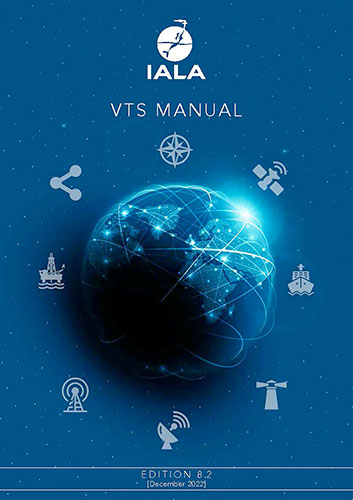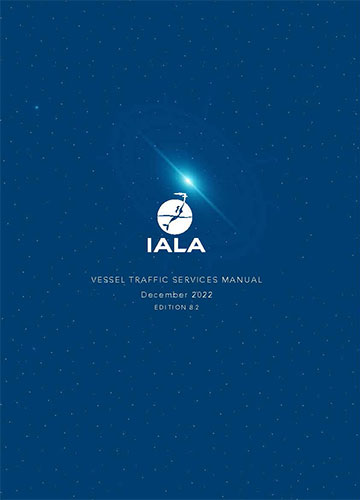VTS Manual, Edition 8,2
Книга на английском языке.
The VTS Manual has been a signature document and information source for Governments, Competent Authorities, VTS Providers, mariners and allied services since first published in 1993.
The Manual is a product of collaboration by the world’s leading experts through the VTS Commit- tee, which has the primary oversight for its compilation and editing.
The membership represents most of the world’s leading national maritime authorities whose dele- gates are widely experienced VTS professionals. The VTS Committee is also supported through participation from relevant international sister organizations. This ensures that the Committee is able to speak with international authority on VTS matters and, importantly, to develop new procedures to meet the emerging needs for modern traffic management and to enhance maritime safety.
The Manual provides a source of reference on the establishment and provision of VTS for all stake- holders. It also provides a pointer to the suite of IALA Standards related to VTS and the associated Recommendations, Guidelines, Model Courses that any VTS professional may seek.
The 2021 edition of the VTS Manual also sees its primary means of distribution being in a digital format which will be available on the website (www.iala-aism.org) along with all the other information sources available to our members and users of Marine Aids to Navigation.
I encourage readers of this Manual to also consult the website for other information that may assist you in your day-to-day work in VTS.
I would like to thank the IALA membership for helping to produce this 2021 edition of the VTS Manual and reflect on the unique nature of IALA that allows professionals from around the world to contribute their expertise to assist the international maritime community in improving and harmonizing VTS.
Contents
1. Introduction to Vessel Traffic Services (VTS)
1.1. What is VTS ?
1.2. Purpose of VTS
1.3. Benefits of VTS
1.4. Development of VTS - A Brief History
2. Regulatory and Legal Framework
2.1. Introduction
2.2. International Convention for the Safety of Life at Sea (SOLAS)
2.2.1. SOLAS Chapter V Regulation 12 - Vessel Traffic Services
2.3. IMO Resolution A.857(20) Guidelines for Vessel Traffic Services
2.3.1. IMO Maritime Safety Committee Circular (MSC.1/Circ.1065, as amended)
2.4. IALA Standards
2.4.1. Recommendations
2.4.2. Guidelines
2.4.3. Model Courses
2.4.4. Documentation Relating to VTS
2.5. National Law
3. VTS Implementation
3.1. Introduction
3.2. Recommendation 0119 - The Implementation of Vessel Traffic Services
3.2.1. Guideline 1150 - Establishment of Vessel Traffic Services
3.2.2. Guideline 1071 - Establishment of a Vessel Traffic Service Beyond Territorial Seas
3.2.3. Guideline 1083 - Standard Nomenclature to Identify and Refer to VTS Centres
3.2.4. Guideline 1142 - The Provision of Local Services Other Than VTS
3.3. Recommendation 0120 - Vessel Traffic Services in Inland Waters
3.4. Recommendation 0102 - The Application of the ‘User Pays’ Principle to Vessel Traffic Services
3.5. Additional Guidance
3.5.1 Guideline XXXX - Competencies for planning and implementing VTS
4. VTS Operations
4.1. Introduction
4.2. Recommendation 0127 - VTS Operations
4.2.1. Guideline 1089 - Provision of Vessel Traffic Services
4.2.2. Guideline 1141 - Operational Procedures for Vessel Traffic Services
4.2.3. Guideline 1110 - Use of Decision Support Tools for VTS Personnel
4.2.4. Guideline 1131 - Setting and Measuring VTS Objectives
4.2.5. Guideline 1045 - Staffing Levels at VTS Centres
4.2.6. Guideline 1118 - Marine Casualty / Incident Reporting and Recording, Including Near Miss Situations
4.2.7. Guideline 1144 - Promulging the Requirement of a VTS to Mariners a VTS Users Guide Template
5. VTS Communications
5.1. Introduction
5.2. Recommendation 1012 - VTS Communications
5.2.1. Guideline 1132 - VTS VHF Voice Communication
6. VTS Auditing and Assessing
6.1. Introduction
6.2. Recommendation 1013 - Auditing and Assessing Vessel Traffic Services
6.2.1. Guideline 1101 - Auditing and Assessing VTS
6.2.2. Guideline 1115 - Preparing for an IMO Member State Audit Scheme (IMSAS) on Vessel Traffic Services
7. VTS Additional Services
7.1. Introduction
7.1.1. Guideline 1070 - VTS Role in Managing Restricted or Limited Access Areas
7.1.2. Guideline 1102 - VTS Interaction with Allied or Other Services
7.1.3. Guideline 1130 - Technical Aspects of Information Exchange between VTS and Allied or Other Services
8. VTS Data and Information Management
8.1. Introduction
8.2. Recommendation 0125 - The Use and Presentation of Symbology at a VTS Centre
8.3. Recommendation 1014 - Portrayal of VTS Information and Data
9. VTS Technologies
9.1. Introduction
9.2. Recommendation 0128 - Operational and Technical Performance of VTS Systems
9.2.1. Guideline 1111 - Preparation of Operational and Technical Performance Requirements for VTS Systems
10. DATA Models and Data Encoding
10.1. Introduction
10.2. Recommendation 0145 - The Inter-VTS Exchange Format (IVEF) Service
11. Training and Assessment
11.1. Introduction
11.2. Recommendation 0103 - Training and Certification of VTS Personnel
11.2.1. Guideline 1156 - Recruitment, training and assessment of VTS personnel
11.2.2. Guideline 1017 - Assessment of Training for VTS
11.2.3. Guideline 1027 - Simulation in VTS Training
11.2.4. Guideline 1103 - Train the Trainer
11.2.5. Model Courses
11.2.5.1. Model Course V-103/1 - VTS Operator Training
11.2.5.2. Model Course V-103/2 - VTS Supervisor Training
11.2.5.3. Model Course V-103/3 - VTS On-The-Job Training
11.2.5.4. Model Course V-103/4 - VTS On-The-Job Training Instructor
11.2.5.5. Model Course V-103/5 - The Revalidation Process for VTS Qualification and Certification
12. Accreditation, Competency, Certification and Revalidation
12.1. Introduction
12.2. Recommendation O-149 - Accreditation of Training Organisations
12.2.1. Guideline 1014 - Accreditation and Approval Process for VTS Training Courses
13. Risk Management
13.1. Introduction
13.2. Recommendation 1002 - Risk Management for Marine Aids to Navigation
13.2.1. Guideline 1018 - Risk Management
13.2.2. Guideline 1123 - The Use of IALA Waterway Risk Assessment Programme (IWRAP MK II)
13.2.3. Guideline 1124 - The Use of Ports and Waterways Safety Assessment (PAWSA) MK II Tool
13.2.4. Guideline 1138 - The Use of the Simplified IALA Risk Assessment Method (SIRA)
14. Quality Management
14.1. Introduction
14.2. Recommendation O-132 - Quality Management for Aids to Navigation Authorities
14.2.1. Guideline 1052 - Quality Management Systems for Aids to Navigation Service Delivery
15. Additional Guidance Related to the Provision Of VTS
15.1. Introduction
15.2. Recommendation A-123 - The Provision of Shore Based Automatic Identification System (AIS)
15.3. Recommendation A-126 on the use of the Automatic Identification System (AIS) in Marine Aids to Navigation Services
15.3.1. Guideline 1082 - An Overview of AIS
15.4. Guideline 1105 - Shore-Side Portrayal Ensuring Harmonization with E-Navigation Related Information
16. IALA
16.1. Introduction
16.2. Aim
16.3. Vision
16.4. Standards
16.5. Membership
16.6. Council
16.7. Committees
16.7.1.VTS Committee
16.8. World-Wide Academy (WWA)
17. Definitions
17.1. Definitions
Annex




